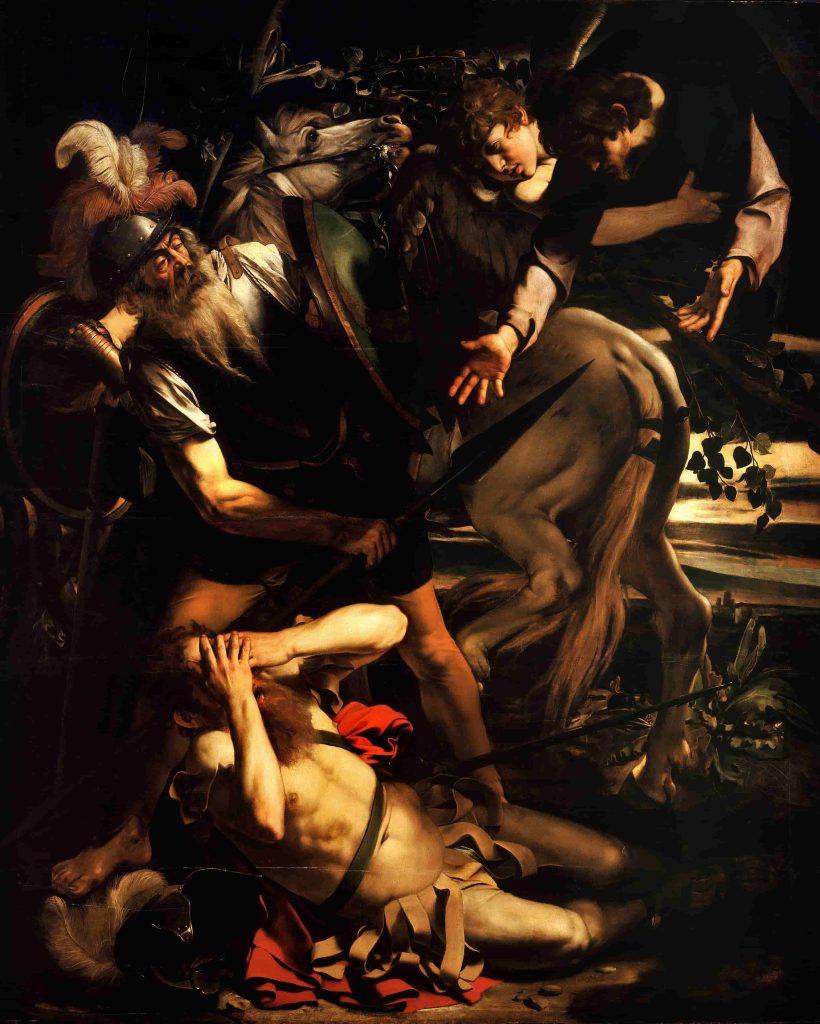An analysis of Caravaggio’s The Conversion of St. Paul and its representation of the powerful transformation of the future apostle.
The Meaning of ‘Conversion’ and Its Relevance to the Painting
The term ‘conversion’ is derived from the Latin word ‘conversio’, which denotes a movement from one place to another, a turning towards something or someone, or a change of direction.
Although the word itself does not necessarily connote any religious or moral significance, it presents boundless possibilities for internal and external transformation. Change can happen by deliberate choice or can be brought about unexpectedly by life’s unpredictable events, which often add new shades and dimensions to our existence.
Caravaggio’s renowned painting, The Conversion of St. Paul, portrays such a transformative moment, where everything changed for the future apostle to the people. It was a pivotal moment, one in which he became acutely aware that nothing would ever be the same again.
The intense flash of insight that he experienced, imperceptible to those around him, was the impetus that launched him from one point in his life to another. The painting’s central figure illustrates the power of a moment that propels us towards a new destination.
St. Paul’s Encounter with Jesus: Background
St. Paul’s conversion, a pivotal moment in Christian history, saw the transformation of a notorious persecutor of Christians into a devout believer. The event, which occurred during his journey to Damascus and involved a dramatic encounter with Jesus, is documented in three accounts in the New Testament book of Acts.
This conversion is significant for two reasons. Firstly, it allowed Christianity to expand beyond its Jewish roots and reach a wider audience. Secondly, it made Paul one of the most important figures in the early Church, as evidenced by his extensive missionary work and writings.
Following his conversion, Paul spent three years in Arabia before embarking on a missionary journey across the Roman Empire. His letters to early Christian communities, a significant part of the New Testament, played a crucial role in the development of Christianity.
St. Paul’s conversion represents a powerful transformation that has had a lasting impact on Christian theology and practice. His life and work continue to inspire Christians today.
Caravaggio’s Style and Aesthetic Break from his Contemporaries
Caravaggio’s oil on canvas painting, The Conversion of St. Paul, was completed in 1601 under commission by Tiberio Cerasi. The artwork is one of two commissioned by Cerasi, the other being The Crucifixion of St. Peter, both of which are now preserved in the Cerasi Chapel of the Basilica of Santa Maria del Popolo in Rome.

Despite Caravaggio’s current acclaim as a master artist, his contemporaries did not initially appreciate his work due to his break from the pre-established aesthetic criteria of his time. Caravaggio introduced a new way of creating and experiencing art, characterised by stylistic and conceptual elements that were not well understood by his peers. Nonetheless, he pursued his artistic vision unencumbered by the norms and conventions of the time.
As a result, The Conversion of St. Paul is a testament to Caravaggio’s dramatic style and intense approach to capturing the moment of conversion. He portrays the transformative moment with unfettered intensity, using light and shadow to create a striking contrast that emphasises the dramatic effect.
Composition of Caravaggio’s Conversion of Saint Paul
The painting represents a clear stylistic break for Caravaggio and this is perceptible in every aspect of the artwork, from practical to theoretical. The first sign of this change is evident in the composition itself.
Typically, the protagonist of a painting was placed in the centre of the composition, but in The Conversion of St. Paul, the centre is occupied by a horse, which is being restrained by an elderly gentleman to prevent it from trampling on Paul, who had been thrown off his horse due to a sudden startle.
This unique composition immediately captures the attention of the viewer and creates a sense of drama and intensity that is characteristic of Caravaggio’s work. The absence of a central figure adds to the realism of the scene and makes it all the more relatable for the audience.
Significance of Horse and Elderly Man
In the painting, the horse appears to be the only one to have truly perceived the profound transformation of Saul, which resulted in his “death” and the “birth” of Paul.

The animal’s tense muscles convey the difficulty of holding it back, indicating the powerful change that has taken place. On the other hand, the elderly man holding the horse seems to be more focused on the animal rather than the man on the ground.
There are some discrepancies in how the event was perceived by those who were with the apostle on the road to Damascus, according to the Acts of the Apostles and the letters of Paul.
Before his conversion, Saul was a zealous Jewish pupil of Gamaliel on his way to Damascus to suppress the growing Christian community. However, he was blinded by a great light and transformed by the voice of Jesus, asking him why he persecuted him, which led to his conversion.
The Power of the Voice and Light in the Conversion
In the painting, the elements that led to Paul’s conversion, the voice and the light, are of particular interest. The voice, although not audible to the viewer, is conveyed through the use of colour that vibrantly fills the space and creates a sense of power.

The light is also crucial, as it blinds Paul but simultaneously illuminates both him and the viewer, allowing us to bear witness to the transformation.
The presence of light in the scene and the absence of it in Saul’s eyes highlights the meeting and dialogue between Paul and his new God; and though dressed, paradoxically he seems naked in front of the truth.
Capturing the Paradoxical State of Paul’s Conversion
In the painting, Paolo appears to have lost not only his helmet, which lies on the ground beside him, but also his sense of self. As someone who was once resolute in his beliefs, he is now adrift without certainty, and his arms are raised as if seeking guidance. He hears a voice speaking to him, but he can no longer see. He is enveloped by light, yet finds himself in a state of darkness.

The painting captures Paul’s fear, wonder and isolation with a balance between pictorial technique and scriptural knowledge. While the composition adheres to the religious subject, the originality lies in the distribution of colours and characters, as well as the ability to create a sense of presence and participation.
Rather than being a detached observer, the viewer becomes fully immersed in the scene and experiences it as part of that world, in that moment.
The Conversion of St. Paul is a powerful representation of a transformative moment that changed the course of Christian history. The artwork’s unique composition, dramatic style and intense use of light and shadow capture the paradoxical state of Paul’s conversion.
The painting exemplifies Caravaggio’s break from the traditional aesthetic criteria of his time, making it a testament to his artistic vision and courage to follow it.




















